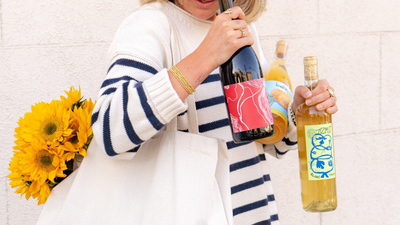Eric Rodez & Charles de Cazanove
The other day a fellow wine industry person was telling me about a method champenoise bottling they recently uncorked and very much did not enjoy. “I mean, it’s a natural wine!”, they exclaimed in the end by way of explanation, and it got me thinking: Wherever you land on the whole ‘natural wine’ question, Champagne kind of seems like its natural antagonist. At root, ‘natural wine’ is supposed to signal a commitment to minimal intervention on the winemaker's part - shepherding fruit-to-juice and grape-to-glass with the fewest possible fingerprints. Champagne by contrast demands - from assemblage to liqueur du tirage to remuage to dosage - almost ceaseless tinkering. Fussiness is kinda the whole point; all the effort it takes to make everything effervesce just right really underlines the extent to which the wine can’t just make itself.
Which got me wondering: can these warring imperatives ever be reconciled and, if so, what would that look like? If natural wine is the thesis, Champagne the antithesis, what is the synthesis?
Maybe Eric Rodez knows. After all, he represents the 7th generation of his family to grow grapes and make Champagne in Ambonnay, the Grand Cru Village for which he served as mayor from 2008-2014. He also worked as a winemaker at the legendary Krug house for a while, and is a 5-time winner of the prestigious ‘Mr. Champagne’ title. But, most importantly for our purposes, he has been making awesome bubbly under his own name for many years and, despite the pedigree and all the accolades (only one of which I made up), he is hardly complacent. Indeed, Rodez has proven quite willing to rethink and change the fundamentals of his craft in search of greater quality and consistency. A disappointing 1984 harvest occasioned trips to other French wine regions to learn new soil maintenance and fertilization practices, which resulted in an increasingly organic and holistic approach to the land. In 2007, the winery made a commitment to total transparency in its practices as it moved towards organic and biodynamic conversions. In 2012, they became the first French farm to receive “high environmental value” certification.
While these practices and certifications, quite rare and difficult in the region, are consistent with the values espoused by most ‘natural’ winemakers, Rodez’s approach remains painstaking even for Champagne. While working at Krug, Eric developed a passion for blending grapes and vintages to achieve a better balance. Many, if not most Champagnes are primarily from one year, perhaps with small amounts of a couple of other proximate vintages added, but Rodez relies heavily on reserve wines, interpolating anywhere from five to ten different vintages in the final cuvees. As he says: "It's the creation of something new, like putting musical notes down on paper. And you're never sure where the melody will go. "You try to direct it, but it's like walking up a circular staircase without knowing where it will lead. I find that incredibly exciting."
Anyway, for me, the result of all this careful praxis is a near ideal alloy of nature and nurture, gorgeous bottlings that feel incredibly refined but not at all forced. The cuvee we are featuring this month is the flagship Grand Cru blend, a combination of 2 grapes and several vintages.
The other selection, despite coming from an equally established and long-standing Champagne house, by necessity contrasts sharply with the Rodez operation. Charles de Cazanove is a vast large endeavor, producing some 3 million bottles annually and boasting a storied history of presentation to kings and heads of state, and partnership with institutions like the Cannes Film Festival. Though it was founded as a family concern, it has been owned by such boldface names Martini &Rossi and Moet and Chanon. Today, it is helmed by another family company and the Tete du Cuvee bottling we have here is a triumph of regional and institutional know-how: one of the best $40 Champagne that I have come across.
Sante!
The PlumpJack Wine Team
|
Eric Rodez Cuvée de Crayères Grand Cru |
|
|
From: Ambonnay, Montagne de Reims, France |
About the Winemaker: The Rodez family has been producing their own Champagne for generations, not simply selling their grapes to large houses. Records show that Jean-Baptiste produced in 1757, Marie-Louis in 1786, Louis in 1819, Eugene in 1850, Camille in 1877, Pol in 1905 and Jean in 1931. Each generation has added several small parcels of vineyards, giving them additional material with which to blend. Eric's son Mickaël patiently waited his turn in line and then became the domaine’s vineyard manager, as the 9th generation of the family! His son Pol-Auguste will perhaps soon be the 10th. Assemblage/Vinification: The vineyards are worked in a traditional way, just like Mickaël’s great-grandparents once worked the soils. They have always hesitated to use the word organic, because they are not certified. But as a grower, Eric (and now Mickaël) never uses pesticides, fertilizers or synthetic sprays on his plants. They plow their soils and limit their yields through careful pruning. They have worked biodynamically for several years now, and in 2012 received the Haute Valeur Environnmentale (HVE) certificate given to farmers who achieve organic farming but also biodiversity and water management on their farms The cuvee Crayères is made on average from a dozen different wines from 4 to 5 different vintages, with 20 to 25% of wines vinified in small oak barrels, with 45 to 50% reserve wines helping to bring homogeneity. Tasting Notes: Gold in hue with small golden highlights. The nose reveals floral and mineral notes allowing upon aeration the release of red and white fruits. The palate is fresh and generous, playing with notes of spring berries. |
|
Winemaker: Eric & Mickael Rodez |
|
|
Price per bottle / Price per case: $94.99/$1025.90 |
|
|
Suggested Food Pairing: Smoked Trout Canapes, Lobster Roast Chicken Dishes w/ nutty and creamy sauces. |
|
|
Charles de Cazanove Tete de Cuvee Brut NV |
|
|
From: Reims, France |
About the Winemaker: The Charles de Cazanove brand is one of the oldest in the Champagne region. It was started in 1811, by Charles Gabriel De Cazanove – an unusual deviation for a man from a long line of master glassmakers. From early on in their history, Charles de Cazanove was supplying European politicians and diplomats, as well as many French presidents. In 1983, leading winemaker, Christophe Rapeneau, joined Charles De Cazanove. He modernized the winery to guarantee the authenticity of the wines being crafted. Partnering with local grape growers and partners all over the Champagne region, Charles De Cazanove crafts and produces champagnes made from rich, varied blends - which satisfy and tantalize a wide variety of tastes all over the world. Assemblage/Vinification: 45% Pinot Noir from the Montagne de Reims;. 38% Pinot Meunier from the Marne Valley; 17% Chardonnay from the Côte des Blancs. 37% Reserve wine 10 g/l dosage. Tasting Notes: The fine bubbles form a large string against a golden background. A fruity nose and delicious, persistent barley sugar and brioche flavors. A very lively wine that is very versatile. |
|
Winemaker: Christophe Rapeneau |
|
|
Price per bottle / Price per case: $39.99/$431.90 |
|
|
Suggested Food Pairing: As an aperitif or with shellfish, pork dishes, mild and soft cheeses and rich fish. |
|




